Note
Can you do Korean??
I can indeed!
My apologies for the extended hiatus. The holidays and subsequent work had me busy and a tad lacking in energy! This post was admittedly a bit difficult to craft, as I have never seriously studied Korean in the past. I wanted to be sure to provide a decent embrace of the language, which meant poring through Korean history and falling down a couple of proto-language rabbit-holes, which I'll get into in a bit. This post also admittedly turned into a general history post in the middle. Anyway, enjoy!
~KOREAN~ (한국어 or 韓國語)
한국어 (romanized in the South as "hangug-eo" and in the North as "han'gugŏ") can be translated as "language of Korea" (a fitting description - it's precisely that!). As far as linguists are concerned, Korean is, besides the Jeju language, considered a language isolate. What this means is that Korean has no known (that is, proven) immediate relatives, being the sole known member of a “Koreanic” language family. However, attempts have been made to connect Korean to a broader "Altaic" family, a controversial theory which has little mainstream support within the linguistic field, that links the Turkic, Mongolic, and Tungusic languages to Korean, Japanese, and even Ainu (some proponents of the theory even throw Basque and Georgian in).

About 79,300,000 people around the world speak Korean natively, with the largest share of these speakers residing on the Korean Peninsula. The largest Korean-speaking community outside of Korea is located in the United States, where it is spoken mostly in immigrant communities in places like Hawaiʻi, on the west and east coasts, and in major urban areas (like New York, Los Angeles, and Chicago).
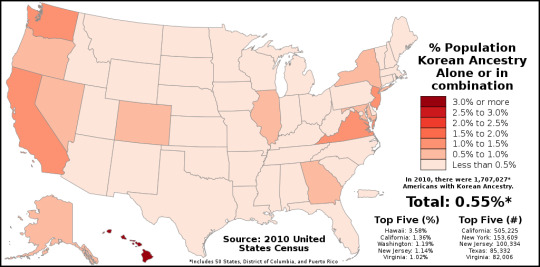
You'll notice up in the title that I included some traditional Chinese characters. In fact, prior to the development of the current writing system - Hangeul (한글)/Chosŏn'gŭl (조선글) - in 1443 by King Sejong the Great, these Chinese characters were used to write the Korean language (Note: in 1443, Korean was still in its "Middle Korean" phase, so some sounds - and therefore characters - have fallen out of use since). These Chinese characters are known as Hanja (한자/漢字), a word that still literally means "Chinese characters" in both Korean and Chinese (to clarify, the word is hànzì in Mandarin, but the characters are the same (at least in traditional environments)). Literacy in Hanja was never widespread, and Hangeul was developed to remedy this and promote widespread literacy in the Korean language. It faced opposition for the first hundred or so years of its existence, mainly from scholars who were proficient in Hanja and worried about their social status being called into question. Despite this opposition, it enjoyed widespread success in broader society, including amongst women (which, in the face of a patriarchal Confucian societal order, was quite a girl-boss moment). Every October 9th in South Korea, Hangeul is celebrated during a national holiday known as "Hangeul Day".

For representing Korean in the Latin alphabet, several systems, collectively known as "romaja" (in hangeul: 로마자; in hanja: 로마字), have been developed. The most widely used romanization system for Korean is known as Revised Romanization (RR), adopted by the South Korean government in the year 2000. In the North, a different romanization system known as McCune-Reischauer (MR) is used. There are a few key differences between the two systems - MR includes breves and apostrophes to indicate certain vowels and syllable boundaries, respectively, whereas RR favors adding an "e" to said vowels and favors hyphens over apostrophes. There are a few other romanization systems, but these two systems are better for representing the spoken language more accurately.
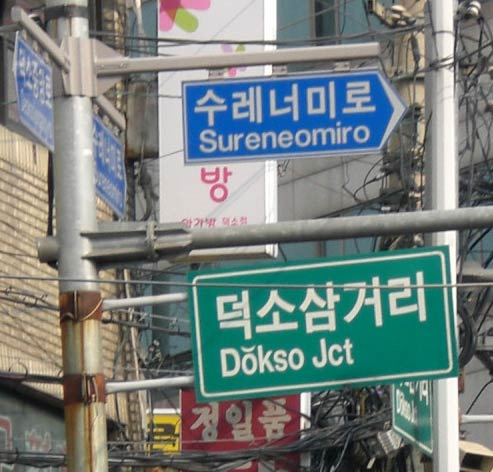
Korea's culture has the ability to endlessly fascinate, with many instantly recognizable hallmarks such as traditional architecture, dress styles, food, film, television... and how could I forget music? (Please understand that I can't cover the entire corpus of Korean media in this one post - after all, this is a blog dedicated to linguistics.) Korea's modern culture still fits quite harmoniously into its more ancient culture (indeed, it's one of the oldest continuous cultures in the world), particularly in the way art is informed by and builds upon older expressions. Korean language and culture have been influenced heavily by that of its neighbors, China and Japan (일본), but remains fundamentally distinct from either; while ideas and concepts have flowed into the peninsula from far afield (e.g., India (인도) and Tibet (뵈)), Korea has done an amazing job at remaining characteristically Korean.

Just how ancient are Korea's roots? Where did the Koreans come from? Genealogy studies point to an origin somewhere in the north of the peninsula, or even further afield, though likely in Manchuria (만주), a region in what is today northeast China (종궈), as well. Though linguistics and genealogy usually have shockingly little to do with each other, this may explain some ancient linguistic borrowings from then-neighboring cultures, like the Mongols (for a large period of history, however, it was difficult NOT to have contact with the Mongols) and Tungusic peoples of northeastern Asia. This contact, at least at the surface, lends itself to the Proto-Altaic theory, but my official stance is still anti-Proto-Altaic (though I'm happy to be proven wrong given further evidence).
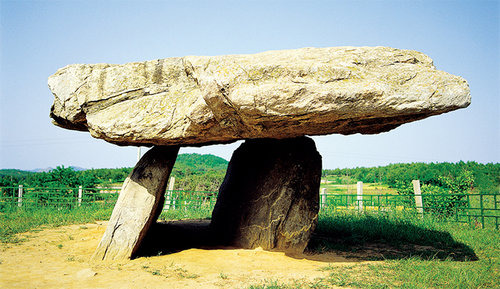
Korean culture has remained remarkably consistent, with hallmarks of the culture such as the hanbok (한복)/chosŏn-ot (조선옷) having remained more or less the same since the era of the Yemaek (예맥) people, a tribal group which can be considered "Proto-Korean". According to a legendary account known as the Samguk Yusa (삼국유사), written in the 1280s, the oldest country-type-thing that can be considered "Korea" was the Gojoseon kingdom (고조선), founded in northern Korea and Manchuria in 2333 BCE, having descended from heaven (this founding date/myth is based on... well, not much evidence, but who am I, some Westerner, to say it's incorrect?).

DISCLAIMER: I'm about to go over a ton of Korean history, which can get confusing.
To the south, the Jin state developed around 300 BCE. We don't know much about this state besides its trade relations with the neighbors. The Gojoseon kingdom stuck around for quite some time, eventually experiencing turmoil during the 2nd century BCE, bringing about the establishment of four Chinese Han dynasty commanderies where Gojoseon once stood. Only one lasted longer than a few decades (the Lelang Commandery), which eventually fell to Goguryeo in 313 CE. Shortly after the establishment of the commanderies, the Jin state developed into Samhan (삼한), which translates to "three Hans". This was a group of confederacies that eventually coalesced into the Three Kingdoms: Baekje (백제), Goguryeo (고구려), and Silla (신라). Each of these kingdoms had their own dialect of Korean, though these are quite sparsely attested besides that of later Silla.

Where Gojoseon once stood, there now (that is, between about 100 BCE and 300 CE) existed several smaller states. The most influential of these was Buyeo (부여), a disunited state that expanded at the expense of other small states in the region, like Okjeo (옥저) and Ye (예). In 57 BCE, six chiefdoms in the southeast of the peninsula were united under Hyeokgeose (혁거세) to form the kingdom of Silla. In about 37 BCE (or, according to North Korea, in 277 BCE), a kingdom was founded in the north and central parts of the peninsula called Goguryeo, which would eventually expand to include vast portions of Manchuria and the Korean Peninsula, rivalling the other kingdoms to the south. Goguryeo is the ultimate source of the name "Korea", and many successive states on the peninsula would claim that they were the rightful successors of Goguryeo.
To the south, the third son of a Goguryeo king, Onjo (온조왕), founded Baekje in 18 BCE, claiming continuity with Buyeo. Baekje played a massive role in regional trade, bringing such fundamental institutions as Chinese characters and Buddhism to Japan. In 42 CE, in the south, the Gaya confederacy came into being through an agreement between various small kingdoms. It was never able to coalesce into a kingdom, owing to larger neighbors constantly causing them grief. In 372 CE, Goguryeo, under King Sosurim (소수림왕), would adopt Buddhism (불교) as its state religion. Gwanggaeto the Great (광개토대왕) and his son Jangsu (장수왕), who reigned respectively from 391 to 413 and from 413 to 491, oversaw Goguryeo's golden age, driving the Chinese and Xianbeis out of Korea and unifying with (or rather, subduing) Baekje and Silla in the south. It was about this time that Korean language began to be more heavily influenced by Classical Chinese, especially in more formal settings. Over time, the balance of power on the peninsula shifted, and Silla began to eclipse the other two kingdoms in wealth and power. It annexed Gaya in 562, which further inflated its influence. By this time, the "idu script" had developed, the precursor script to Hanja. In 660, Silla, with help from the Tang dynasty, defeated and absorbed Baekje. After a coup and several other incursions by Silla and the Chinese, Goguryeo also collapsed in 668.
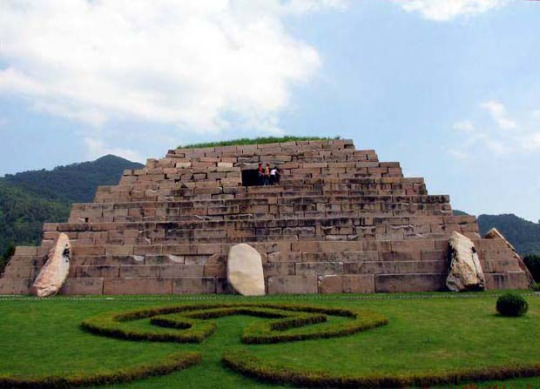
Are you with me so far? We only have about 1,300 years left to cover!
Next we have the Northern and Southern States Period (남북국시대), which lasted between 698 and 926. The "northern state" in this era was Balhae (발해), and the "southern state" was a unified Silla kingdom (통일신라). It was during this period that Old Korean evolved into Middle Korean (the year 918 is the generally agreed-upon boundary). Balhae was established by Dae Joyeong (대조영), also known as King Go (고왕), who was previously a Goguryeo general. Balhae encompassed, at its peak, a sizeable portion of Manchuria, most of modern North Korea, and a big chunk of Russia's Primorsky Krai. Silla laid claim to all lands to the south. During the Northern and Southern States Period, both kingdoms were remarkably advanced culturally and technologically, rivalling and at times surpassing their neighbors in China. Many Buddhist monasteries founded during this period are still in operation today, many of which are considered UNESCO World Heritage Sites.
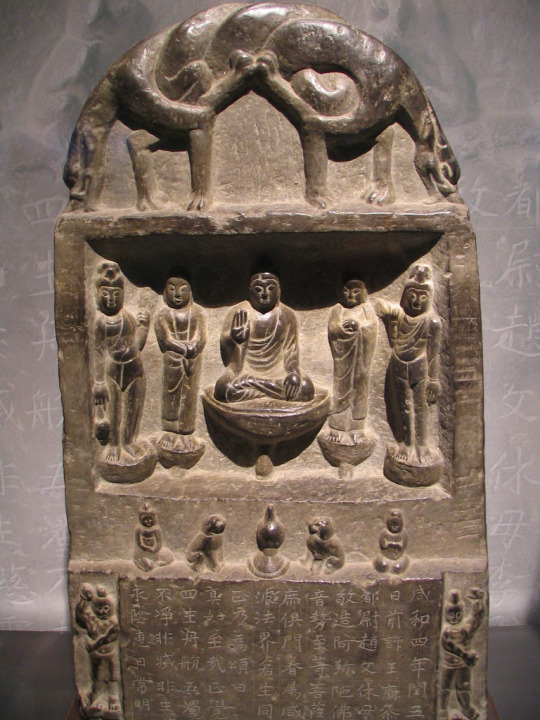
Towards the end of the Northern and Southern States Period, internal strife erupted within the two kingdoms, particularly in Silla, leading to the revival of Baekje and Goguryeo. During this period of decline, known as the Later Three Kingdoms period, Taejo Wang Geon (태조 왕건) founded the Goryeo dynasty in 918, and out of the ashes of the previous kingdoms, Goryeo rose up and consolidated power over most of what is today Korea. In classic Korean fashion, Wang Geon claimed Goryeo to be the successor state to Goguryeo. Buddhism again saw a flourishing during this period, reaching its influential zenith and being codified into a legal system which spread across the peninsula. During the Goryeo period, metal movable type was invented, the first of its kind in the world. In 1104, the Jilin leishi (鷄林類事) was written by Sun Mu (孫穆), a Song Chinese ambassador. This work is notable for providing information about the Early Middle phase of the Korean language, though it doesn't give as good of an insight into the phonology of the language at the time. We can, however, tell that Middle Korean did indeed have tones, like Chinese. Until its ultimate demise in 1392, Goryeo was at the cutting-edge of various technological advancements, including gunpowder weapons and paper. This level of technological prowess aided Goryeo in fending off such foreign assaults as that of the Chinese Liao dynasty and of the Mongols under Kublai Khan. In 1388, Yi Seong-gye (이성계) wrested control of Goryeo during a coup, and in 1392 founded the Joseon dynasty.

In 1392, Yi Seong-gye, also known by his regnal name of Taejo (태조) founded the Joseon dynasty (조선), which would last until 1897. He established the dynasty on Confucian (유교) values, perpetuated by a class of seonbi (선비), a scholarly elite class of public servants. During this period, the capital moved to its modern location - Hanyang (한양) (later renamed "Seoul" (서울)). Most modern dialects of Korean can trace their origin/divergence to the beginning of this era. Later in this period, the Korean language evolved into its Early Modern form, around the year 1600. In 1394, Neo-Confucianism was officially adopted as the state philosophy, which led to a strengthening of bureaucracy. Taejo's grandson, Sejong the Great (mentioned above), helped to usher in yet another golden age of education, science, and advancement in the arts, many achievements of which were unparalleled anywhere else in the world at the time.

Between 1592 and 1598, Japan invaded Korea under the command of Toyotomi Hideyoshi (豊臣 秀吉) in an aggressive expansionist plot to overrun vast swathes of the Asian mainland. This plot was ultimately thwarted, however, thanks in no small part to the military prowess of the Korean navy under Admiral Yi Sun-sin (이순신), whose turtle ships proved indispensable in the war effort. Two subsequent invasions, this time from the Manchu in the north, left Joseon reeling; however, this era was instrumental in the forging of the modern Korean national and ethnic identity. Into the 1800s, corruption and isolationism led Korea to be known as a "hermit kingdom", a title still used to disparage the DPRK. The peasantry of the nation suffered greatly under the thumb of corrupt government officials during this period. Inefficiency within the government dragged various processes into multi-generational efforts, such as the abolition of slavery (which took 93 years, ultimately being completed in 1894). Despite Korea's isolationist policy, there were several instances of American contact with Korea during the mid- to late-1800s - kept at arm's length, the Americans (usually shipwrecked in the rocky waters surrounding the peninsula) were treated hospitably and sent to China after a short while. Contact with the West during this period wasn't entirely fantastic, however - I urge you to look into incidents such as that of the General Sherman and the US campaign into Korea known locally as Shinmiyangyo (신미양요).
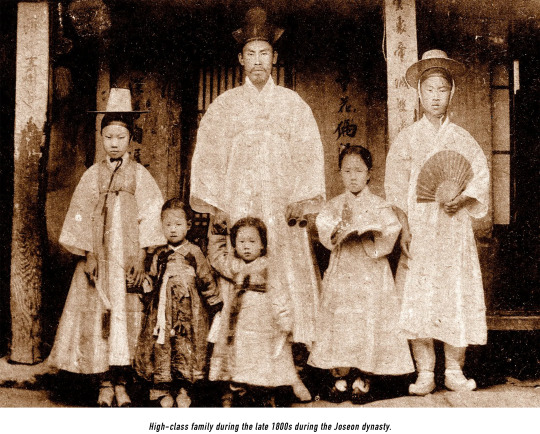
From about this time until after the Korean War, Korea's history is wrought with, to put it lightly, nastiness. Around the end of the Joseon dynasty, the Korean language entered its modern phase, which is an innovation broadly shared across the peninsula, at least up until the division of the Koreas in 1945. Across the sea in Japan, expansionist and imperialist ideas were taking hold, and Meiji Japan set its sights once more on the mainland. Japan defeated Qing China in the First Sino-Japanese War in 1895, drawing Korea into its sphere of influence. In 1910, after several more years of fighting, Japan formally annexed Korea into its empire. Japan proved to be a ruthless and destructive occupying force, instilling Japanese cultural and linguistic policies at the expense of the native Korean way of life. They committed atrocities against the populace (content warning for that hyperlink: discussions of SA), particularly against Korean women, many of whom are still alive today. These atrocities have not been acknowledged or apologized for by the Japanese government to this day. Koreans were forced to change their names to Japanese names (some say it wasn't mandatory, but merely strongly encouraged), and the Japanese utilized forced labor in camps and, in 1944, began drafting Koreans into their army.
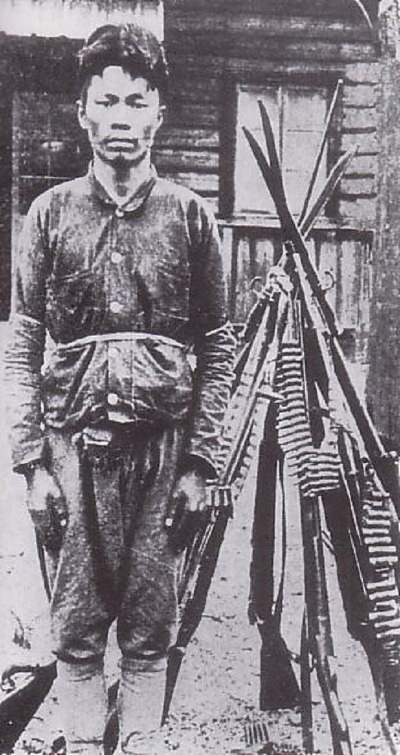
Now for the elephant in the room: why do the North and South have separate standards for the same language? (This section is unfortunately also not all smiles and rainbows.) As much as I would love to chalk this up to general regionalized dialect differences (which do exist), it has everything to do with the protracted conflict on the Korean Peninsula between two fundamentally opposed ideologies, which manifest themselves as the Democratic People's Republic of Korea in the North and the Republic of Korea in the South. The DPRK's government espouses an official state ideology known as "Juche" (주체사상/主體思想 (MR: Chuch'e sasang), meaning literally "subject/consciousness idea"), which emphasizes self-reliance and sovereignty of the self and of the nation. While in development by Kim Il-sung (the DPRK's founder and first leader), it was initially regarded as a variant of Marxist-Leninist thought, but as a result of various alterations made by his son, Kim Jong-il, it should no longer be regarded as such, and care should be taken to distinguish Juche from other socialist ideologies.
During the Cold War era, the United States and its allies wanted to hold communism at bay, and the Korean War (known in the North as the "Fatherland Liberation War", in the South as the "625 War", and in the United States as the "Forgotten War") was one of many manifestations of this decades-long ideological conflict. The South, supported by the United States and its allies, fought a war with the North, supported by the Soviet Union, China, and their allies. Over the course of three years (from 1950 to 1953), the front lines moved up and down the peninsula, but even to this day the war has seen no formal end, and the two nations remain locked in "frozen conflict". The two Koreas do not recognize each other's sovereignty, and this has had various repercussions (whether directly or indirectly) for the state of the Korean language in either nation. Along with the examples of romanization mentioned above, there are many other differences in the spoken and written language. For example, as the DPRK's ideology espouses total self-reliance, their dialect is considered to be more "conservative" (not politically, but linguistically - this means that more native Korean terms have survived foreign influence and fewer foreign borrowings of vocabulary have been picked up by the population). In the ROK, many loanwords have been imported from foreign languages, particularly from English, and everyday speech is regarded as less formal in register.

Speaking of formality registers, did you know Korean has them? Seven of them, in fact, and speakers switch between them to alter how politely/formally they are perceived. These registers change depending on who you're talking to - are they older? Younger? About the same age? Royalty? Whatever the scenario, these registers have you covered. (As long as you use them properly, that is.)
Let's look deeper into the language itself - how is it structured? Korean sentences have basic "SOV" word order - that is, subject-object-verb, as opposed to English's subject-verb-object. Korean is also an agglutinative language - that is, it "glues" various grammatical particles onto words in order to convey meaning. Various particles are used to denote the subject/object of a sentence, the level of formality, and other grammatical functions necessary to convey the full meaning of a sentence. Below, I've borrowed a diagram from Lingodeer that breaks down word order with color-coding. To denote each portion of the sentence, a particle (such as 는 (neun), 에서 (eseo), etc.) is added to the base word (저 (jeo), 집 (jib), etc.) to facilitate understanding.

All of this may seem daunting at first for an English-speaking learner - a different writing system, a different grammar, wildly different vocabulary - but like any language, all it takes is exposure and consistent practice to master. The US State Department considers Korean a Category IV "super-hard" language, with the likes of Arabic, Japanese, Cantonese, and Mandarin, but I personally don't subscribe to the notion that any one language is "harder" than any other. Sure, there's fewer familiar elements in these languages, but with enough exposure, it doesn't matter if you're learning Korean or Dutch, it will eventually fall into place. Patience is the name of the game! Trust in the process and you will see results. Perhaps you're planning a trip to Korea, perhaps you have Korean-speaking family members and want to connect with them, or perhaps you're a fan of Korean cinema or of Korean music and want to understand what's being said. Lucky for you, there's a wealth of resources both online and in print that facilitate the learning process. YouTube is full of Korean-language videos spanning many genres (from instructional videos to daily vlogs), and everyone's favorite owl has a course of his own available for free.
I would be interested in creating a separate post for the Jeju language if there is enough community interest, so please let me know if this is something you would be interested in! It's an often-ignored and critically endangered language spoken on Jeju-do, an island between South Korea and Japan, that has been developing in parallel with the Korean language for centuries and is thus mutually unintelligible with most mainland Korean dialects.
There's no possible way I can fit every facet of the language and the people who speak it into this one little post, so please let me know if you have any further language questions, either about Korean or any other language! Feel free to comment your favorite piece of Korean culture below.
Follow for more linguistics and share this post! Again, feel free to ask about any language!
16 notes
·
View notes
Text
Reposting in case people missed this!
GULF ARABIC
!السلام عليكم
First, I'd like to thank everyone for 50 followers! Please keep sharing these posts and feel free to suggest a language or ask a linguistic question!
As the FIFA World Cup progresses through the knockout stage, I'd like to take a dive into the dialect of Arabic spoken in the host country, Qatar.

Arabic as a language is a very broad umbrella encompassing a wide array of dialects spoken from the Maghreb (Morocco, Algeria, Mauritania, etc. -- the term "Maghreb" (الْمَغْرِب) literally means "the west") to the Arabian Peninsula, and from the Horn of Africa to the Levant. Gulf Arabic, the focus of today's profile, is spoken on the western and southern shores of the Persian Gulf, and to a lesser extent, on the northeast shore. According to Glottolog, Gulf Arabic can be classified as part of the North Arabian Bedouin Arabic set of dialects, part of the Peninsular Arabic branch of the Arabic family. Ultimately, it is a Central Semitic language, the same branch of languages that is home to Hebrew, Phoenician, Ugaritic, Aramaic, and a host of other languages originally native to the Middle East.
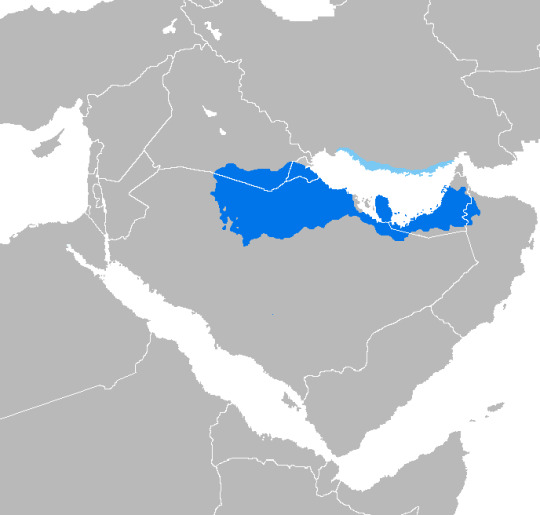
Gulf Arabic is spoken by about 10.6 million people (both natively and as a second language), mostly in the Gulf region but also in diaspora. Known locally as "Khalījī" (roughly, "of the Gulf"), this dialect has several features that distinguish it from its dialectal neighbors and from Modern Standard Arabic (MSA, or al-Fuṣḥā - the language of most literature, media, and practically anything else across the Arab world besides vernacular, colloquial Arabic).
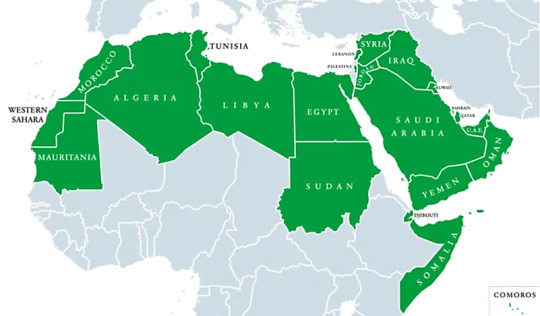
Before we dive into particulars, let's take a look at the name, "Qatar". A direct borrowing from Arabic "قَطَر" ("qaṭar" transliterated into the Latin script), it's quite often mispronounced* in English-language media. The Gulf Arabic vernacular pronunciation of the nation's name can be represented in IPA (International Phonetic Alphabet, a.k.a. one of my favorite things) like so: [ˈɡɪtˤɑr]. For the uninitiated, imagine saying the English word "guitar" with emphasis on the first syllable. In the video at the beginning of >this article<, the host uses more of a Modern Standard pronunciation, as evidenced by the initial consonant and vowel ("qa" as opposed to "gi").
*However, if someone says something and they mispronounce it or it's not technically a word and you're still able to comprehend what they're trying to say, I say leave it be! It's the polite thing to do, after all.

The Arabic language originated perhaps as far back as 800 BCE somewhere in the northwestern part of the Arabian Peninsula. Some dialect of Arabic (though certainly not as differentiated as today's Khalījī) was already spoken in Qatar by the time Muhammad sent Al-Ala'a Al-Hadrami (العلاء بن الحضرمي) to spread the message of Islam to the area in 628 CE (6-7 AH) (note: it is customary within Islam to follow the Prophet Muhammad's name with an honorific, which this website explains a few of). (If anything in this paragraph is incorrect or disrespectful, please let me know!)
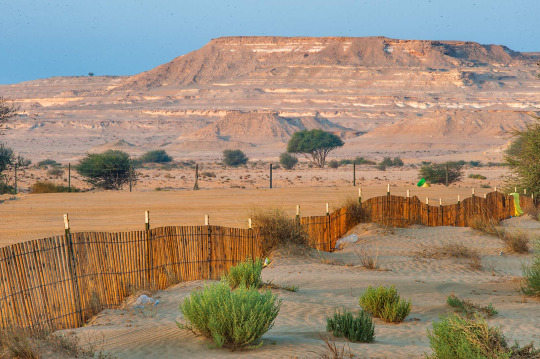
As the centuries passed, empires and caliphates rose and fell. Control over the peninsula changed hands several times well into the modern period. Qatar declared independence from - gasp! - Great Britain only on September 3, 1971, and it had previously been under the control of the Ottomans, Saudis, Persians, and many other dominant regional powers.

Owing perhaps to such a tumultuous regional history, Gulf Arabic's phonology has made some notable shifts away from Classical Arabic (the basis for MSA). Due to influence from an influx of foreign workers (particularly from South Asia), a foreign "p" sound has entered the dialect that distinguishes itself from the "b" sound, an expressly non-native phenomenon requiring a modified letter. Remember that "g" sound in "Qatar" from earlier? This is another of the more visible phonological shifts - though depending on the speaker, some may realize this sound like a Persian "q" (something like a "g" but pronounced back by the uvula), a French "r" (you know the one), an English "g" (phew!), or even like a Classical Arabic "q" in some instances.
I have not personally attempted to learn Gulf Arabic, so I can't give my recommendation on any particular learning apparatus over any other, although this website has a few potential paths to proficiency. However, if you find yourself in Qatar for business or pleasure, you may or may not be pleased to find that English is quite commonly spoken among native Qataris, owing to the nation's recent colonial past with Great Britain.
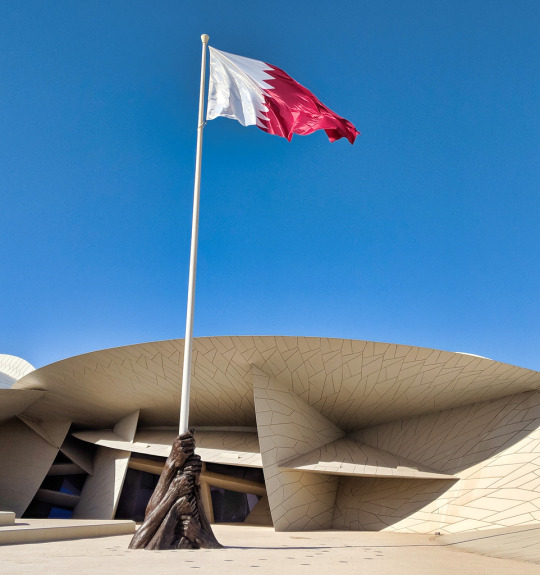
I would also like to make mention of a hidden gem you may have noticed within this World Cup's logo: the "t" in "Qatar" is quite stretched.

This "stretchy letter" phenomenon is known as "kashida", a borrowing of the Persian "kešide" (کشیده), which means "long" or "weighted" (or, in this instance, "extended"). It can be used for various purposes, such as emphasis of pronunciation or meaning, or as an effort by a calligrapher to fill extra blank space. In many stylized calligraphic texts written in Arabic and its descendant scripts, kashida is perhaps one of the more recognizable techniques utilized, even to someone with no knowledge of what is written.
Here's a link to some Gulf Arabic greetings complete with sound files. Even making the effort to learn some of these will go a long way in opening new doors to you!
Here's a playlist of music by Qatari artists! Listen to the sounds of the Gulf.
I understand this post is quite Qatar-centric, but if you're interested in hearing more about the history and culture of the other areas where Gulf Arabic is prominent (Kuwait, UAE, etc.) let me know and I'd be more than happy to talk about them!
What language would you like to see me profile next? Comment or send me a message! Please follow, share, like, and reblog for more linguistics!
10 notes
·
View notes
Note
What languages are you learning??
Thank you for the question!
Currently, my focus is to get as close as possible to fluent in Scottish Gaelic. Next, I would like to brush up on some languages that I haven't used or practiced in a while, such as Dutch or German.
I have a few ideas floating around in my head for what to focus my energy on next, but Turkish and Arabic have recently caught my eye, as well as perhaps one of the Slavic languages (Ukrainian, Russian, Serbo-Croatian, etc.). However, I think it would be neat to learn all of the languages from my 23andMe first!
I would also like to learn the indigenous language from the area I grew up in! I feel as if it would increase my connection to the land; even basic knowledge, like knowing the names of geographical features, can give vital clues into the history of places, and knowing the terms for plants can provide hints as to what they can be used for.
I encourage anyone and everyone to learn new languages! It can open up entire new realities to a learner. Language has the power to bond us all together as a species! It's the bridge that crosses the gap of misunderstanding that so plagues our world.
Thanks for the question! Feel free to ask more anytime! Follow for more language.
#ask me anything#thanks for the ask!#gaidhlig#scottish gaelic#scotland#langblog#languages#langblr#linguistics#language#23andme#indigenous#geography#culture
10 notes
·
View notes
Note
What languages are you fluent in??
Currently I would only consider myself fluent at a native level in American English, with Inland North and Midland accent features tinting an otherwise "General American" accent.

However, I could probably stumble my way through a conversation in Scottish Gaelic, Standard Mandarin Chinese, and perhaps Dutch! At different points in the past, I probably could have added Danish, German, Vietnamese, or even Latin to this list, but it's been quite some time since I've had any practice. I might be able to surprise myself with Spanish solely based off of passive exposure from growing up around bilingual signage in certain situations and hearing it spoken every so often (and from a few attempts to learn here and there).
Fluency as a concept can mean different things to different people based on language goals. Languages are multi-faceted - they involve speaking and listening as well as (in many cases) reading and writing. When I learn (perhaps to my own disadvantage), I try to improve all of these things in tandem, but many learners of languages (particularly aspiring polyglots) opt for only the first two.

A big milestone that I've accomplished is attaining a working knowledge of the International Phonetic Alphabet. It's been an indispensable tool when learning how to sound as close to native as possible when learning other languages! It helps to comprehend different languages' orthographies (writing systems) and phonologies (sound systems) quite handily.

Thank you for the question! Please feel free to ask more!
#ask me anything#thanks for the ask!#langblog#langblr#languages#linguistics#native language#learning languages#polyglot#scottish gaelic#gaidhlig#chinese#dutch
7 notes
·
View notes
Text
GULF ARABIC
!السلام عليكم
First, I'd like to thank everyone for 50 followers! Please keep sharing these posts and feel free to suggest a language or ask a linguistic question!
As the FIFA World Cup progresses through the knockout stage, I'd like to take a dive into the dialect of Arabic spoken in the host country, Qatar.

Arabic as a language is a very broad umbrella encompassing a wide array of dialects spoken from the Maghreb (Morocco, Algeria, Mauritania, etc. -- the term "Maghreb" (الْمَغْرِب) literally means "the west") to the Arabian Peninsula, and from the Horn of Africa to the Levant. Gulf Arabic, the focus of today's profile, is spoken on the western and southern shores of the Persian Gulf, and to a lesser extent, on the northeast shore. According to Glottolog, Gulf Arabic can be classified as part of the North Arabian Bedouin Arabic set of dialects, part of the Peninsular Arabic branch of the Arabic family. Ultimately, it is a Central Semitic language, the same branch of languages that is home to Hebrew, Phoenician, Ugaritic, Aramaic, and a host of other languages originally native to the Middle East.

Gulf Arabic is spoken by about 10.6 million people (both natively and as a second language), mostly in the Gulf region but also in diaspora. Known locally as "Khalījī" (roughly, "of the Gulf"), this dialect has several features that distinguish it from its dialectal neighbors and from Modern Standard Arabic (MSA, or al-Fuṣḥā - the language of most literature, media, and practically anything else across the Arab world besides vernacular, colloquial Arabic).

Before we dive into particulars, let's take a look at the name, "Qatar". A direct borrowing from Arabic "قَطَر" ("qaṭar" transliterated into the Latin script), it's quite often mispronounced* in English-language media. The Gulf Arabic vernacular pronunciation of the nation's name can be represented in IPA (International Phonetic Alphabet, a.k.a. one of my favorite things) like so: [ˈɡɪtˤɑr]. For the uninitiated, imagine saying the English word "guitar" with emphasis on the first syllable. In the video at the beginning of >this article<, the host uses more of a Modern Standard pronunciation, as evidenced by the initial consonant and vowel ("qa" as opposed to "gi").
*However, if someone says something and they mispronounce it or it's not technically a word and you're still able to comprehend what they're trying to say, I say leave it be! It's the polite thing to do, after all.

The Arabic language originated perhaps as far back as 800 BCE somewhere in the northwestern part of the Arabian Peninsula. Some dialect of Arabic (though certainly not as differentiated as today's Khalījī) was already spoken in Qatar by the time Muhammad sent Al-Ala'a Al-Hadrami (العلاء بن الحضرمي) to spread the message of Islam to the area in 628 CE (6-7 AH) (note: it is customary within Islam to follow the Prophet Muhammad's name with an honorific, which this website explains a few of). (If anything in this paragraph is incorrect or disrespectful, please let me know!)

As the centuries passed, empires and caliphates rose and fell. Control over the peninsula changed hands several times well into the modern period. Qatar declared independence from - gasp! - Great Britain only on September 3, 1971, and it had previously been under the control of the Ottomans, Saudis, Persians, and many other dominant regional powers.

Owing perhaps to such a tumultuous regional history, Gulf Arabic's phonology has made some notable shifts away from Classical Arabic (the basis for MSA). Due to influence from an influx of foreign workers (particularly from South Asia), a foreign "p" sound has entered the dialect that distinguishes itself from the "b" sound, an expressly non-native phenomenon requiring a modified letter. Remember that "g" sound in "Qatar" from earlier? This is another of the more visible phonological shifts - though depending on the speaker, some may realize this sound like a Persian "q" (something like a "g" but pronounced back by the uvula), a French "r" (you know the one), an English "g" (phew!), or even like a Classical Arabic "q" in some instances.
I have not personally attempted to learn Gulf Arabic, so I can't give my recommendation on any particular learning apparatus over any other, although this website has a few potential paths to proficiency. However, if you find yourself in Qatar for business or pleasure, you may or may not be pleased to find that English is quite commonly spoken among native Qataris, owing to the nation's recent colonial past with Great Britain.

I would also like to make mention of a hidden gem you may have noticed within this World Cup's logo: the "t" in "Qatar" is quite stretched.

This "stretchy letter" phenomenon is known as "kashida", a borrowing of the Persian "kešide" (کشیده), which means "long" or "weighted" (or, in this instance, "extended"). It can be used for various purposes, such as emphasis of pronunciation or meaning, or as an effort by a calligrapher to fill extra blank space. In many stylized calligraphic texts written in Arabic and its descendant scripts, kashida is perhaps one of the more recognizable techniques utilized, even to someone with no knowledge of what is written.
Here's a link to some Gulf Arabic greetings complete with sound files. Even making the effort to learn some of these will go a long way in opening new doors to you!
Here's a playlist of music by Qatari artists! Listen to the sounds of the Gulf.
I understand this post is quite Qatar-centric, but if you're interested in hearing more about the history and culture of the other areas where Gulf Arabic is prominent (Kuwait, UAE, etc.) let me know and I'd be more than happy to talk about them!
What language would you like to see me profile next? Comment or send me a message! Please follow, share, like, and reblog for more linguistics!
#Afro-Asiatic#language#linguistics#culture#langblog#langblr#languages#arabic#arab#qatar#qatari#persian gulf#fifa 2022#world cup#fifa world cup#sports#soccer#football
10 notes
·
View notes
Note
And another question re: Gaelic post…can you talk more about Scots, and how it came to be seen as the more “educated” language compared to Gaelic, as well as how the language is viewed now?
Barrie quaisten!
SCOTS
Scots is another Anglic language closely related to English. There is heated debate (often, unfortunately, along political party lines) over whether it should be considered a language or a dialect. However, the linguistic consensus is that Scots is indeed its own distinct language, complete with its own vocabulary, grammar rules, and historical character. It's akin to the relationship between Danish and Norwegian - while they share a relatively recent common ancestor and have influenced each other over the course of history (however lop-sided that influence may be), they are indeed separate languages.
Around the 600s CE, a new language appeared in the southeast corner of Scotland, back when this area was under the control of certain new-ish arrivals to the island who spoke a Germanic tongue. At this point, Middle Irish (modern Gaelic's immediate ancestor) was the court language of Scotland, and would remain so until the reign of David I, crowned in 1124. Scots is said to have begun diverging from the Northumbrian Old English dialect in earnest by the 1100s, although records of the language are sparse before about 1375 (the beginning of the Early Scots literary period) owing to Viking and English "meddling" (some light raiding here, some plundering there, general theft, and so on). Owing to its Northumbrian origin and heavier Scandinavian influence (stemming from close ties with the Danelaw), Scots has more of an Anglian and Norse character to it as opposed to its relatively more Saxon-y, Norman-y cousin to the south (i.e., English). Scots has also had much closer contact with languages like Scottish Gaelic and even Pictish and Cumbric (which I'll be sure to cover in a future post), and as a result has been influenced in its vocabulary and phonology.
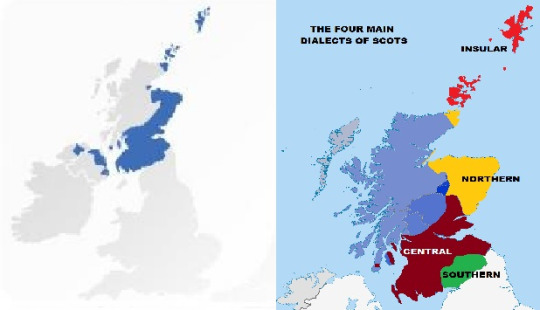
It has several dialects of its own, broadly categorized by location, ranging from Borders Scots to Orcadian Scots and everything in between. (And we can't forget Ulster Scots, a dialect brought to Ulster during the 1600s by Lowlander planters.) Due to this variation, modern Scots has no clear standardized form, though linguists have made several halfway-serious attempts over the past century or so to standardize orthography.
But what's been going on with Scots between David I and the present day? Let's dig in.
David I (in Gaelic, Daibhidh I mac Mhaoil Chaluim), who reigned from 1124 to 1153, initiated the proliferation of proto-urban societies across his kingdom. These societies were called "burghs", or "touns" in Scots, and they'll come in handy later. At about this same time, Norman French began to infiltrate the Scottish nobility, and Gaelic began to decline as a language of prestige among higher levels of society.
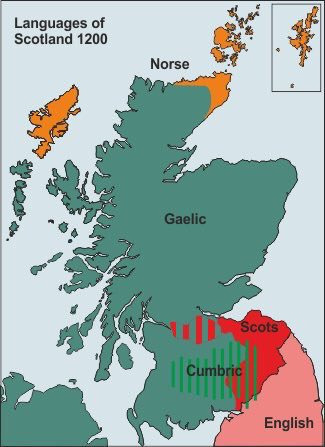
Once the 1200s started to creep around, the northern dialect of Early Middle English that would become Scots began expanding ever northward towards the Forth-Clyde line. This dialect was called "Inglis" by its speakers, and over the next century, it began to supplant Norman French and Gaelic as a common language within the burghs. The 1300s saw this "Inglis" tongue grow in prestige and it began to eclipse Norman French at even the higher levels of society, particularly within the courts. As the 1400s approached, it even began to replace Latin as the language of ecclesiastical and royal court proceedings.
The 1400s saw a relatively rapid geographic spread of Scots at the expense of Gaelic, which was cornered into the Highlands, Western Isles, and small pockets in the Lowlands (viz. Galloway, where Gaelic survived at least up to 1760). By the early 1500s, Scots began to be known as "Scottis", and Gaelic, which had previously been referred to thus, was now being dubbed "Erse" ("Irish") in attempts to otherize Gaelic. The 1500s saw the advent of Middle Scots, which was, in my amateur opinion, the golden era of the language, owing to its undisputed support at all levels of society across most of the kingdom. Around this time, a loose written standard did exist, but the language was still written how it sounded and regional variation was commonplace.

1567, however, saw the coronation of James VI of Scotland (note: James I of England and Ireland as well from 1603 on). His famous Bible translation (KJV) helped to set in motion the gradual Anglicization of Scottish society as it was dispersed among the population. In 1603, the Union of the Crowns brought Scots-speaking and English-speaking nobles into closer contact, and English gradually began to dominate the speech of the Scottish nobility (this exchange would produce what is now Scottish English, a distinct standardized dialect of English that some argue is one end of a linguistic spectrum, at the other end being "braid Scots").
Beginning in 1610 and continuing through to the 1690s, Scottish planters from across the western Lowlands and the Borders began to settle in Ulster, the northeastern region of Ireland. Over time, this group of people would come to develop their own regional identity, the Ulster Scots (or, often in a New World context, Scots-Irish). Their local dialect of Scots, while maintaining a Lowland character, picked up various influences from Hiberno-English (particularly in phonology) and from the Irish language (various contributions of vocabulary).

By about 1700, written Scots, at least in an official capacity, had become almost completely Anglicized. An example of an Anglicized convention introduced to Scots writing is the "apologetic apostrophe", an apostrophe that was inserted into a Scots word where an English-speaking person might expect a letter to be (for example, the Scots word "wi" (in English, "with") would have been written wi'). In 1707, the Acts of Union (Note: Panama played a role) seemed to solidify a shift in the upper-class opinion of the Scots language - what scarcely 150 years before was seen as the national language was now looked down upon by the nobility as "uneducated speech" or "bad English".
However, things looked different from a lower- and middle-class perspective. Contrary to high society, the common people began to take a renewed interest in the Scots language, and a literary revival began. This mid-1700s revival gave us such world-famous names as Robert Burns, Walter Scott, and Thomas Campbell. It was at this time that Scots transitioned from Middle to Modern Scots. However, features such as the apologetic apostrophe were retained during this period to gain wider readership among an English-speaking audience, a market that now effectively spanned the globe. (Meanwhile, the Highlands and Lowlands each experienced their own set of Clearances, and Scotland's diaspora began their journey to the edges of the empire.)
By the early 1800s, this "Scots fever" (NOTE: not a technical term) had reached the upper classes of society as they increasingly turned a Romanticist eye to the literature of their homeland, while simultaneously keeping Gaelic at arm's length. Since this point, there hasn't been any sort of top-level, government-sanctioned, institutional spelling reform or rulebook published on Scots orthography, although this hasn't stopped a wealth of Scots poetry and prose from being published through the years.
Since this era, there has been a relatively steady stream of interest in the language, though recent government initiatives have been taken to attempt to ensure the survival of, and increase interest in, Scots. This 2010 study by the Scottish Government sheds some light on modern public perception of the language within Scotland itself.
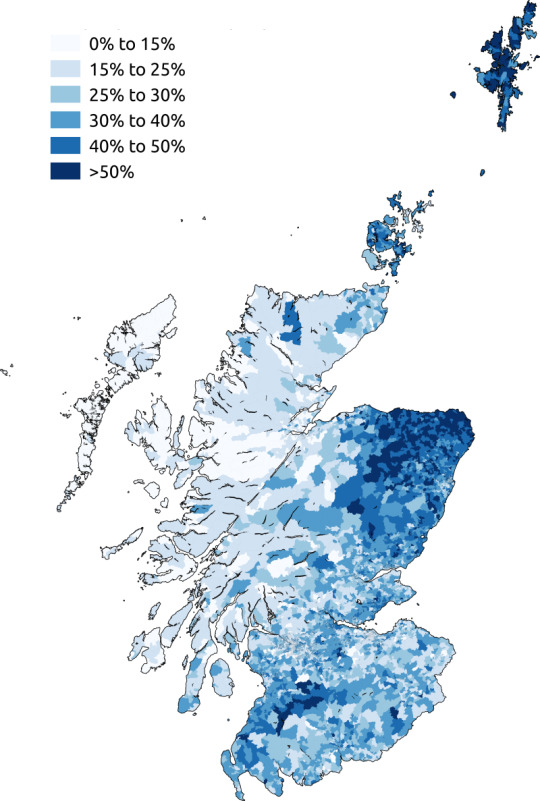
Over in Northern Ireland, the Ulster-Scots Agency was established as part of the wider Belfast Agreement of 1998 in efforts to promote the language and wider culture.

It's not all roses these days, however. A couple of years ago, it came to light that a North Carolina teenager had been, for over seven years, writing entries on the Scots Wikipedia, without any knowledge of the language. One Reddit user remarked that this teenager had caused "more damage to the Scots language than anyone else in history." (Perhaps take this with a grain of salt.)
Would you like to help protect the language?
The best way to protect a language is to learn it! If you click that link, there are several resources for adult learners of Scots to start their journey. My perennial advice, though: once you've got the basics down, use it! Find a Scots speaker and stumble your way through a conversation. Don't be afraid of making mistakes! (Note: everyone makes them.) One resource I've used in the past to learn some basics is the Open University's (entirely free!) Scots language and culture online course. All you need to do is sign up and work through the modules!
Follow for more linguistics and share this post! If you have any questions, feel free to ask!
#scots#scotland#germanic#language#languages#learning languages#langblog#langblr#indo european#united kingdom#ireland#northern ireland#ulster
215 notes
·
View notes
Note
What’s your opinion on the Duolingo Gaelic course? I tried starting it after starting Irish and found the Gaelic 🏴 lessons to be considerably less…polished? in my experience
Excellent question!
Personally, I think it’s a great way to reintroduce a new, younger generation to the language. It covers a lot of cultural topics that many people may never have heard of, like the concept of a Mòd gathering. Additionally, I don't think I had ever heard of IRN BRU, but it’s now on my bucket list to try. (Their adverts alone are, um, quite attention-grabbing.)
According to an article in The Scotsman, as of this March (March 2022, that is - greetings, future readers!), the course has surpassed a million learners, an astounding leap for a language that just decades ago was teetering on the edge of extinction.
And back to the first point, an article in The Guardian made an excellent point about this course helping to dispel the "Scottish cringe", a manifestation of a wider (practically global, though there are exceptions) phenomenon of perceived inferiority of a given indigenous culture in favor of an external, more politically or socially dominant culture or language.
THAT BEING SAID, however, I do have some critiques of my own, and you put forward a good point. From what I understand, the course mainly teaches the Mid-Minch dialect of Scottish Gaelic (shoutout to Sabhal Mòr Ostaig!), with some regional variation in pronunciation between the people providing audio recordings (although they do expose the learner to Canadian Gaelic with a few lessons, which gets a big "thumbs up" from me). With the massive volume of learners coming to the app (an overall very positive thing!) to learn the language, I'm predicting the language will undergo a "dialect levelling" over the next few decades as a result of the popularity of this course. My guess is that the good majority of people learning Gaelic online will start and finish their language learning journey with the Duolingo course and not seek out other resources (or even fellow speakers or learners) to supplement this, which may move Gaelic towards one standard "Duolingo dialect" in the near future if care is not taken to avoid such a fate.
Another thing I've noticed is that as I near the end of the course (I'm on Unit 66 of 69 at the moment), there hasn't been a single prompt for the past fifteen or so units that I haven't already seen. Don't get me wrong, review is always good, but I do wish they would provide more variation in their prompts in the later stages of the course so I could be sure that I'm absorbing more essential vocabulary and grammar and not just drilling myself on Duolingo sentences. I also wish it would cover some more important points of grammar and vocab earlier in the course (concepts in colloquial sentence structure such as how and when to use phrases like "air a bhith", "gum bi", "biodh", etc.). My advice once you've reached about Unit 45 or so is to begin seeking out other learners (or native speakers if you can find them) and begin practicing using the language in a more colloquial fashion.
One note I have about the platform in general: a somewhat common thread among Duolingo learners of any language is that the sentences sound unnatural at times, or that they'll "never use these sentences in real life." While that may be the case in a literal sense, that's not the whole point of the structure of the courses. I think people see sentences like "the bear gave me a strawberry" and think they're not learning anything worthwhile, but what sentences like this teach you is vocabulary in different syntactical situations. This is one of the best ways to learn grammar - that is, to not even realize you're learning it, and to passively absorb it based off of various usage examples. After all, this is how we learn grammar rules as young children! And a side-note, make sure you do the lessons with the sound on, and for your own sake, make sure you're saying each sentence out loud as you go! (Your future conversation partners will thank you for it.)
I also forgot to mention a great resource in my main post - the show Speaking Our Language is available on YouTube for free (at least in the United States), and covers Gaelic as it may be used situationally. It can be a bit goofy at times, and it's a nostalgic snapshot of early- to mid-1990s Scotland, but it's presented in a very digestible and well-paced fashion for learners!
Follow for more linguistics and share this post! If you have any questions, feel free to ask!
#scottish#scottish gaelic#scotland#duolingo#language#languages#linguistics#langblr#langblog#learning languages#celtic#ask me anything#gàidhlig
62 notes
·
View notes
Note
Could you talk about Gaelic? How many people are speak it today?
Indeed I can!
SCOTTISH GAELIC
"Gaelic" as a term can refer to any of the Goidelic branch of languages, which includes Irish, Scottish Gaelic, and Manx. HOWEVER, since today (November 30th) is Saint Andrew's Day, Scotland's national day, let's talk about Gàidhlig na h-Alba, or Scottish Gaelic! Latha Naomh Anndra sona dhuibh!
When referring to Scottish Gaelic, we pronounce the word "Gaelic" not as "gey-lick" but as "gal-lick", owing to its native pronunciation (which you can listen to here).
BEFORE THIS POST GETS TOO LONG, I urge the reader to consider learning this language! It's the source of my name after all ("Ian" is a form of "Iain" or "Eòin", both Gaelic forms of "John") and is the heritage language of as many as 40 million people worldwide. Even if you don't claim any Scottish ancestry, it's a beautiful and poetic language tied to an equally beautiful and poetic culture! Use it as a code language with your friends, read some classic Gaelic literature, or even pay a visit to Scotland and smugly read Gaelic road signs off to your friends/family/tour guide! (They'll love it, I promise.) I personally have been learning via Duolingo and other online resources for about 8 months now. And remember, "Is fheàrr Gàidhlig bhriste na Gàidhlig sa chiste" (better broken Gaelic than Gaelic in the coffin).
As of the 2011 Census, the total number of people within Scotland itself that can speak the language is about 57,000 people, or 1.1% of the population [1]. This is indeed a relatively small number, and according to the Endangered Languages Project the language is "Threatened", but the Scottish Government has produced Gaelic Language Plans about every five years since the passage of the Gaelic Language (Scotland) Act 2005. These plans ensure government commitment to the survival and growth of the language, and indeed the decline in speakers has slowed since 2000, and with luck these trends will reverse in the coming years.

In fact, on October 14 of this year, the Scottish Government released an updated language plan outlining the next five years of government initiatives for the language.
But what is this language?
WARNING: INCOMING HISTORY LESSON!
Scottish Gaelic is a Celtic language that was brought to the west coast of Scotland from Ireland by settlers (named "Scoti" by the Romans) sometime between 300 and 500 CE. These settlers soon established the Kingdom of Dál Riata (a name which means "Riata's territory"). This kingdom maintained close ties with Ulster (roughly modern Northern Ireland), and it was during this early period that Christianity began to take hold across Scotland, with such figures as Saint Columba founding monasteries and institutions of learning. What is today Scotland was fractured between four broad people groups at this point - the Gaels in the west, the Picts in the east, the Angles of Northumbria and Berenicia in the southeast, and the Britons of Strathclyde in the south.
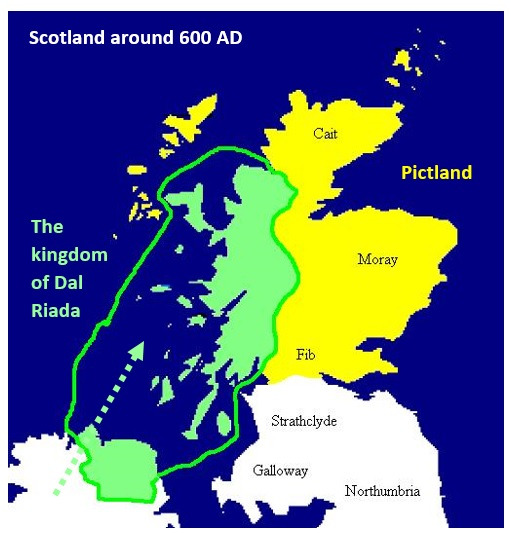
With Christianity came the rapid spread of the Gaelic language into lands outside Gaelic control, especially into the Kingdom of the Picts. Eventually, in the 860s-870s, a certain group called the Vikings appeared. (You may have heard of them.) It was at this time that Scotland unified against a common threat, solidifying the bond between the (likely) Brittonic-speaking Picts and the Gaelic-speaking Scots. Over time, Pictish identity was completely lost (leaving behind difficult-to-decipher standing stones scattered across the countryside), and a unified Kingdom of Alba appeared. (Alba means Scotland - and it's not pronounced how you might think.) Between about 1000 and 1200, Gaelic reached its greatest geographic extent, being spoken across Scotland (the islands at this time were ruled by Vikings, which I'll cover in a later post; however, Gaelic was still spoken, at least in the Western Isles). Some people argue that it was never spoken south of Lothian, but place-name evidence from the Borders calls this into question somewhat (name prefixes such as "bal-" and "kil-" are telltale signs of Gaelic settlements).
Malcolm III (of Macbeth fame), also known as Malcolm Canmore ("ceann mòr", or "big head"), married an Anglo-Saxon princess named Margaret, who had no Gaelic. It was at this time, around 1070, that the first signs of a decline in the language began to appear. Margaret brought English-speaking monks to the Lowlands, in effect drawing a cultural border between Lowlands and Highlands.
By the mid-1300s, Scots, a sister language of English (NOT a dialect!), had become the language of the courts and of the parliament. England, in all its ambition, turned its eyes northward, necessitating an independence struggle (or two, or three...), although this resistance was carried out using Scots (then dubbed "Inglis"), not Gaelic (then "Scottis").

By the time the above image was current (c. 1400), Scottish Gaelic had almost completely split away from Irish, though the written languages were (and to a rough extent, still are) rather mutually intelligible.
Over time, Gaelic became further and further marginalized by Scots. Various government initiatives worked expressly against the language, incentivizing or otherwise encouraging Highlanders to speak the "educated tongue" of the Lowlands. In Scots, Gaelic was called "Erse" (roughly, "Irish"), in a popular effort to "de-Scottify" the language. James VI (and I)'s reign marked a significant downturn in the language's usage. The language was seen as backwards, rebellious, and Catholic (a big no-no in an officially Protestant nation). The language was looked down upon in schools (not to mention broader society) from the 1600s up through the early 1900s, and English became the language of upward mobility for Highlanders and Islanders.
Fuadaichean nan Gàidheal, the Highland Clearances, were a result of the failed Jacobite rebellions throughout the 1700s and the imposition of new systems of land management and ownership. Many Highland families emigrated to the far corners of the British Empire, particularly Canada, the United States, Australia, and New Zealand. Highland culture, for all intents and purposes defunct back home in Scotland, survived in these places into the modern era.
In Canada, Gaelic found much success, especially initially. At one point, Gaelic was the third-most commonly spoken language in Canada, though usage declined markedly between the 1800s and more recent revival efforts in the late 20th century. According to the 2011 Canadian Census, 7,195 people claim "Gaelic languages" as the language they use at home (though this term also includes Irish, Welsh, and Breton, the latter two of which are not Gaelic, but Brythonic). Scottish Gaelic is taught in schools (on an opt-in basis) from primary to university level in Nova Scotia, a province whose name means "New Scotland" in Latin. In Nova Scotia, especially on Cape Breton Island, Highland culture is still very much alive.
What goes on within Gaelic?
Gaelic and its other Celtic cousins are quite unique in the European context, as they place the verb first within sentence structure. It's also quite interesting as its nouns can still inflect for the dual number (at least vestigially), a feature lost in a great many other Indo-European languages (oh, did I mention it's an Indo-European language?). If you've ever seen any written Irish or Scottish Gaelic, you may have noticed they like to put "h" after the first letter of a lot of words. This is a linguistic phenomenon known as mutation, and in this case more specifically as lenition. It changes the pronunciation of the first consonant of the word. This phenomenon has been present in the language since the days of Old Irish (and perhaps even further back into the days of Proto-Celtic).
In terms of spelling and pronunciation, it's astonishingly regular... once you figure out all the rules. There are 11-ish vowel sounds (depending on dialect), and 30 (or so) consonant sounds, a step down from Old Irish's 46 distinct consonants.
To conclude:
If you're committed to learning the language, I would recommend finding fellow learners or even native speakers online, and if you're really, REALLY committed to learning the language, I would doubly recommend making the effort to find a tutor in-person or over Zoom or another video calling service if it's within your means (although this advice goes without saying for learning any language). An institution known as Sabhal Mòr Ostaig, based in the Isle of Skye in the Western Isles of Scotland, must be mentioned in any discussion about learning Gaelic, however. According to their website, they are the "only centre of Higher and Further Education in the world that provides its learning programmes entirely through the medium of Gaelic in an immersed, language-rich environment." (This post is not sponsored.) If you have the time, the money, and the willpower, perhaps give them a look! They work closely with projects such as Tobar an Dualchais and Soillse to preserve, maintain, and revitalize Gaelic language and culture for future generations.
Follow for more linguistics and share this post! If you have any questions, feel free to ask!
#scotland#scottish#gaelic#irish language#scottish gaelic#indo european#linguistics#language#history#culture#celtic#celts#vikings
313 notes
·
View notes
Text
Quechua

Quechua, the language of the Inca. Shown above is its modern distribution. Source: Paul Heggarty (2007)
Quechua is a group of related languages spoken in the central Andean region of South America. Commonly associated with the Inca Empire, these languages are still widely spoken today, and are in fact the most widely spoken indigenous American languages (when viewed as a group). To speakers of the languages, it is usually known as runa simi, which translates to "the mouth/tongue of the people".
These languages have provided English and Spanish with various words -- some more obvious ones include "llama", "Andes", and "Peru". Terms like "jerky" and "guano" have their ultimate source in Quechua as well.

Ancient ruins at Tiwanaku, 72 kilometers from La Paz, Bolivia. Source: backpackdiary.com
Quechua was already spoken across the Andean region well before the Inca Empire was founded and continued to be spoken as the language of administration and daily life even after the Spanish conquest of Peru.
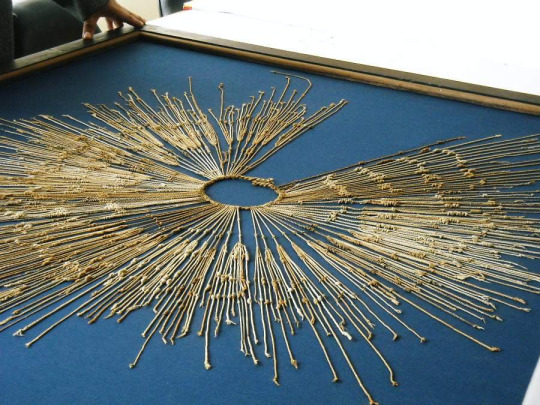
A quipu, a means of record-keeping used across the Andes prior to Spanish conquest. Source: Herb Kasube
Due to long-term contact with Aymara, the two families have had considerable influence on each other.
Quechua languages are agglutinative and are therefore highly inflected; however, adjectives are not declined in agreement with the nouns they affect.
Quechua's literary tradition, though only being written after the Spanish conquest, contains a wealth of stories, both fiction and non-fiction. Some notable authors in the Quechua languages include Kusi Paukar and Jesús Lara. Prior to the conquest, these stories were transmitted orally, usually in a song and/or dance.
Follow for more linguistics and share this post! If you have any questions, feel free to ask!
12 notes
·
View notes
Text

What are those two red lines in the Tarim Basin of what is now China? Source: Wikipedia
Those are the regions where Tocharian was once spoken, an ancient group of languages belonging to the Indo-European family, the same family that includes English, French, Greek, Hindi, and many others. A more proper term for these Tocharian languages might be “Agni-Kuči,” but current consensus generally opts for “Tocharian.”
These languages, of which there were three (aptly named Tocharian A, B, and C), went extinct upon the arrival of the Uyghurs sometime after 840 CE, when the latter group was driven from what is today Mongolia by the Kyrgyz people. The solid red zone in the image denotes Tocharian A and B, while the red outlined zone denotes Tocharian C.
The Tocharians themselves likely practiced Buddhism, having learned to write down their language from Buddhist monks somewhere to the south. Indeed, the Tocharian script is a direct descendant of the Brāhmī script, itself the direct parent system of such varied writing systems as Devanagari, Burmese, and Javanese.

An excerpt of the Tocharian script. Source: omniglot.com
The Tarim mummies also discovered in the area outlined above may be the remains of ancient Tocharian speakers, although the earliest mummies were buried about 1,000 years before the earliest attested inscriptions of Tocharian were written down. Recent genetic evidence suggests they were autochthonous to North Central Asia, though they were heavily influenced by surrounding cultures, likely including the Afanasievo peoples to the north. These Afanasievo peoples would have been a possible source for the Tocharian languages, as they are believed to have spoken an immediate offshoot, or perhaps dialect, of Proto-Indo-European.
Follow for more linguistics and share this post! If you have any questions, feel free to ask!
8 notes
·
View notes
Text
Welcome to the blog! This is where I’ll be passion-posting about language/linguistics stuff (and some history and culture as well). I’ll update as often as I can!
3 notes
·
View notes